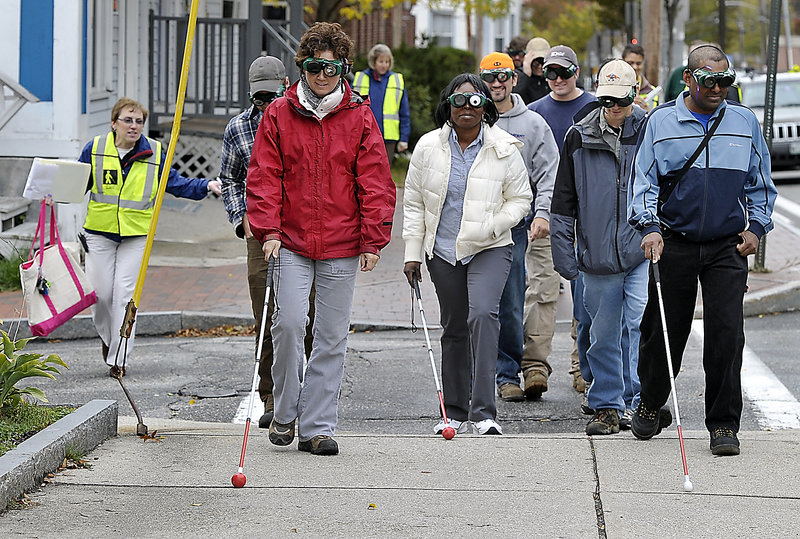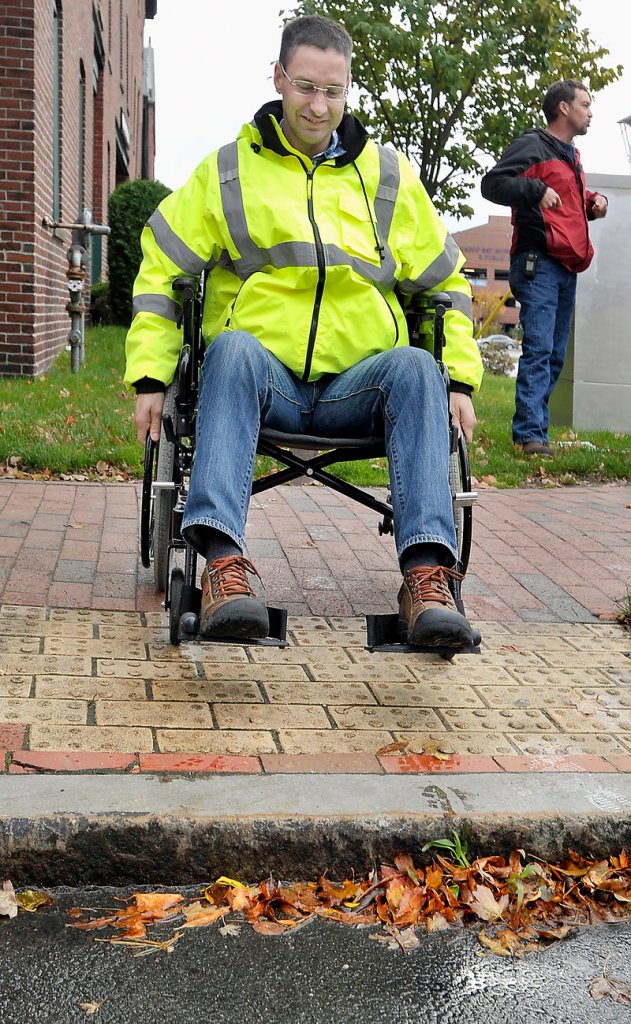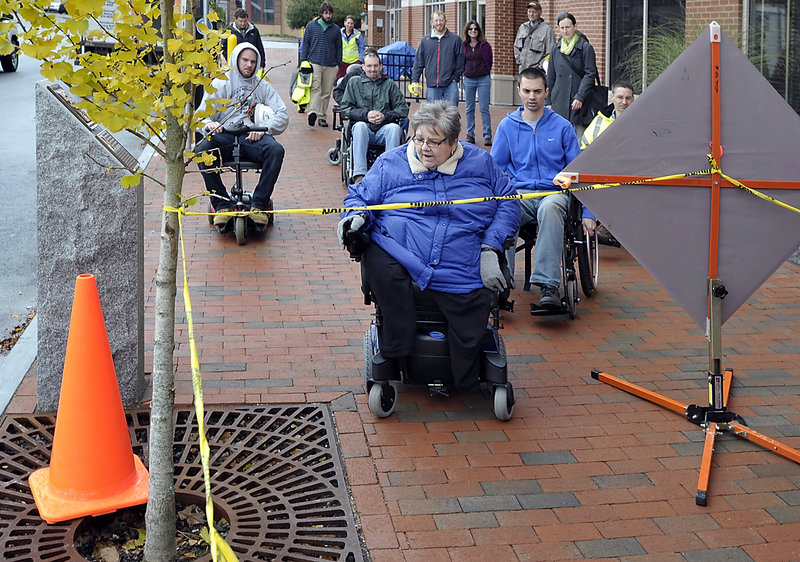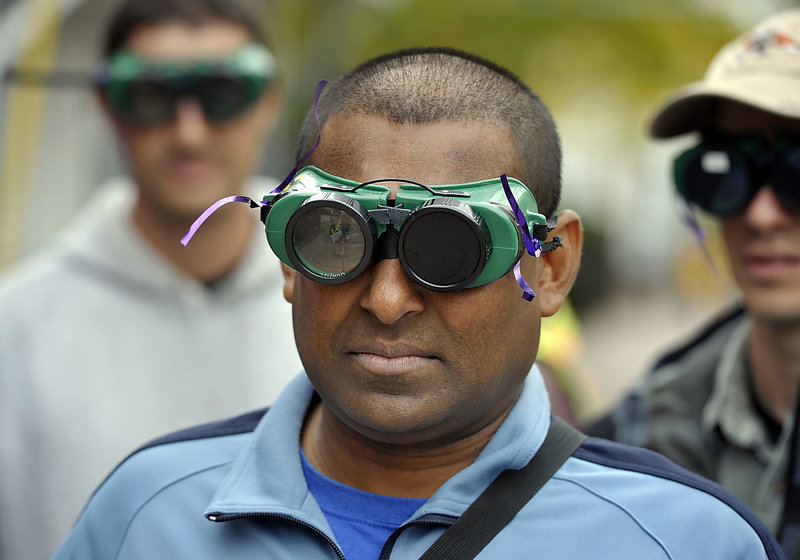– By EDWARD D. MURPHY
Staff Writer
PORTLAND – When a missing brick in a sidewalk on Franklin Street stopped his wheelchair Tuesday morning, Seth Wills didn’t get much sympathy from Penny Plourde.
“Welcome to my world,” Plourde told Wills, who was using a wheelchair to learn about some of the obstacles that people with disabilities face in navigating city streets and sidewalks.
Plourde, who uses a wheelchair, is a consultant to the civil rights office in the Maine Department of Transportation.
Wills and about four dozen other assistant engineers in the department used wheelchairs, wore goggles that simulate vision problems and looked at common walking and biking issues during a daylong session. It was meant to get them thinking about solving traffic problems in ways that help the greatest number of people — or at least that don’t create more problems.
For instance, Wills’ colleague, Eric Rudolph, who also was using a wheelchair, was asked to push a button for a crosswalk signal at the corner of Franklin and Commercial streets.
The sidewalk leading to the button was narrowed by an overgrown bush on one side. A manhole cover created another roadblock. The bricks were uneven and broken.
Rudolph struggled to reach the button, then nearly toppled as he backed away from the light pole holding the button because there wasn’t enough room to turn around.
Rudolph finally had to use his legs to extricate himself from the tight spot, and was kidded about being the beneficiary of a miracle.
Plourde said many people think that careful adherence to the federal Americans with Disabilities Act might make it easy for people to get around in wheelchairs, but that’s not the case.
“Where you get messed up is when you go from a plan to the field and nothing works,” said Plourde, who had one leg amputated as a child because it wasn’t growing correctly, and lost the other after a traffic accident this summer. “Open your eyes to the obstacles. The world is not a flat place — it’s full of all sorts of humps and bumps.”
Like the missing brick, which would most likely be ignored by anyone walking along Franklin Street, the problems are easy to spot once you’ve experienced a few firsthand.
For instance, as the assistant engineers headed down Fore Street, they encountered a hydraulic lift parked in the middle of the sidewalk, surrounded by yellow tape that left no way around it. The group noted that a simple sign at the start of the block saying the sidewalk was impassible would have saved them the effort of turning around and finding another way.
Tim Kelley, an assistant engineer, said the experience gave him a new perspective — literally. “I felt very low” being in a wheelchair, he said. “I felt very unprotected.”
The group definitely attracted attention. A couple of tourists videotaped the group in wheelchairs as they headed down Commercial Street.
The assistant engineers with simulated vision problems drew second looks as they walked near Portland High School, thanks to the big goggles and white canes they used to move carefully down Cumberland Avenue.
But the lessons should be worth a few stares. They’re likely to stay with the assistant engineers, who are working to gain enough experience and training to take tests to become licensed engineers, said Joyce Taylor, director of the Department of Transportation’s bureau of project development.
“These are things you might not experience by reading a book or looking on a computer,” she said.
Encountering the difficulties posed by designs that might have been improved by a broader perspective will go a long way toward avoiding the same mistakes, Taylor said.
“These could lead to a lot of inexpensive changes,” Taylor said. “There are a lot of tweaks and things we can do that don’t break the bank.”
Staff Writer Edward D. Murphy can be contacted at 791-6465 or at:
emurphy@pressherald.com
Send questions/comments to the editors.






Success. Please wait for the page to reload. If the page does not reload within 5 seconds, please refresh the page.
Enter your email and password to access comments.
Hi, to comment on stories you must . This profile is in addition to your subscription and website login.
Already have a commenting profile? .
Invalid username/password.
Please check your email to confirm and complete your registration.
Only subscribers are eligible to post comments. Please subscribe or login first for digital access. Here’s why.
Use the form below to reset your password. When you've submitted your account email, we will send an email with a reset code.